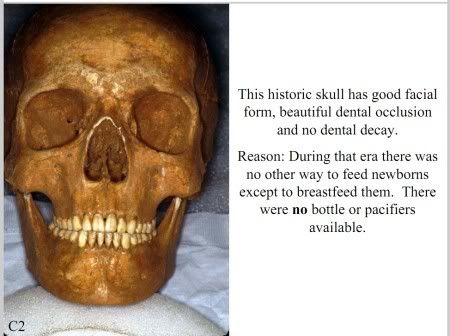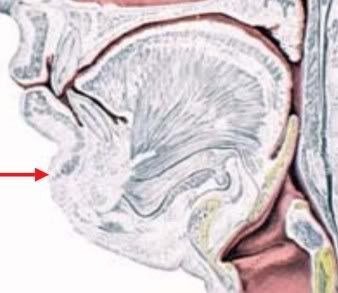Brian Palmer is quite an interesting dentist. He has an entire website (albiet in premodern html) devoted to the importance of breastfeeding. He maintains that infant feeding techniques have an enormous impact on the human oral cavity and airway, which in turn has an effect on infant problems such as SIDS and ear infections, adolescent problems such as overbites, and even adult disorders such as obstructive sleep apnea.
I won't get into all of his hypotheses here, but I was interested in what he says about SIDS. Human babies have unique mouths and airways. Their epiglottis, or the flap that covers the airway when you swallow, is high up in the back of the mouth. It comes into contact with the soft palate, or the soft back of the roof of the mouth. The soft human nipple encourages the tongue and lower jaw to come forward in the mouth, and pulls the epiglottis up, reinforcing its position.
This is the position all other mammals have as well. It lets them hork down food more safely while still breathing. Eventually, however, your baby's epiglottis will adopt a position lower in the throat. This is weird and complicated and unlike other mammals, but it does two things: it enables human speech, and it enables the tongue to drop back and block the entire airway (which is what happens with obstructive sleep apnea). But you were breastfeeding, so your kid's tongue and lower jaw will be anatomically correct position: forward and away from the nose-to-lung airway path. Human nipple feeding also molded your baby's hard palate (the bony roof of the mouth), making it wider, which enhances airflow around the tongue.
You can read his presentations (in PDF format) on SIDS and breastfeeding here. They're a bit anatomy-heavy but have fun slides like this:
He also theorizes that this same process of bad mouth molding due to poor infant feeding practices contributes to obstructive sleep apnea in children and adults, otitis media in children, of course there are the dental and orthodontic implications of having your bite messed up by plastic nipples and pacifiers. I haven't even begun to dig through his three-part text The Importance of Breastfeeding to Total Health which may cover all these topics more generally.
Maybe this doesn't seem interesting to everyone, but to me, SIDS is a perplexing event that requires explanation. Also weird is the occurrence of "difficult airways" at work: people who are just really difficult to intubate. Sometimes it's due to overweight, or biting, but I wonder how often it's due to misshapen palates, jaws, and oropharynxes. A difficult intubation in an emergency can be absolutely fatal. Breastfeeding might help in more ways than we have previously imagined.![]()
I won't get into all of his hypotheses here, but I was interested in what he says about SIDS. Human babies have unique mouths and airways. Their epiglottis, or the flap that covers the airway when you swallow, is high up in the back of the mouth. It comes into contact with the soft palate, or the soft back of the roof of the mouth. The soft human nipple encourages the tongue and lower jaw to come forward in the mouth, and pulls the epiglottis up, reinforcing its position.
 |
| The epiglottis is that thin white thing clamping onto the back of the roof of the mouth, preserving airflow from the nose to the lungs. From a slide by Palmer. |
You can read his presentations (in PDF format) on SIDS and breastfeeding here. They're a bit anatomy-heavy but have fun slides like this:
 |
| Those are some nice teeth. |
Maybe this doesn't seem interesting to everyone, but to me, SIDS is a perplexing event that requires explanation. Also weird is the occurrence of "difficult airways" at work: people who are just really difficult to intubate. Sometimes it's due to overweight, or biting, but I wonder how often it's due to misshapen palates, jaws, and oropharynxes. A difficult intubation in an emergency can be absolutely fatal. Breastfeeding might help in more ways than we have previously imagined.
